|
|
本帖最后由 lilyma06 于 2012-1-12 10:34 编辑
China's skyscraper craze 'may herald economic crash' Tall-building boom may indicate impending disaster in China and India, claims report by Barclays Capital
http://www.guardian.co.uk/business/2012/jan/11/skyscrapers-china-india-recession
 The Burj Khalifa in Dubai, currently the world's tallest building at 828 metres. Photograph: Reuters The Burj Khalifa in Dubai, currently the world's tallest building at 828 metres. Photograph: Reuters
China could be the next country to go bust, if its headlong rush to build ever-taller skyscrapers is a guide to its future economic health.
According to a study by Barclays Capital, the mania for skyscrapers over the last 140 years is a sure indicator of an imminent crash.
It points out that the construction boom that threw up New York's Chrysler and Empire State buildings preceded the New York crash of 1929 and Great Depression.
More recently, Dubai built a forest of skyscraping offices, hotels and apartment buildings, including the world's tallest, the Burj Khalifa, before it got into terrible financial difficulties. In 2010 Dubai had to be bailed out by its neighbour, Abu Dhabi, to avoid going bankrupt.
Bar Cap's report said: "Thankfully for the world economy, there is not currently a skyscraper under construction that is planned to overtake the height of the Burj Khalifa."
However, BarCap said the "unhealthy correlation" between construction of the world's tallest buildings and economic crashes was likely to ensnare China, which is home to half of the world's skyscrapers currently under construction.
India, which has just two skyscrapers, sometimes defined as buildings over 240 metres (787ft) tall, is also on the radar after giving the go-ahead to its first skyscraper building boom, with 14 under way, including the world's second-tallest tower in the financial capital, Mumbai.
Andrew Lawrence, director of property research at Barclays Capital in Hong Kong, said: "Building booms are a sign of excess credit."
Lawrence said that historically, skyscraper construction had been characterised by bursts of sporadic, but intense activity that coincided with easy credit, rising land prices and excessive optimism, but often by the time the buildings were finished, the economy had slipped into recession.
China is already showing signs of fulfilling the prophecy. Its largest quarterly business survey showed that confidence among property developers had collapsed to a point where it was worse than the lowest point in the 2008 recession.
More worringly, the same survey revealed that confidence among construction firms, while a little down on the previous quarter, remained bouyant. Capital Economics, the independent analysts, said Beijing's decision to pump hundreds of billions of dollars into construction projects, bypassing private developers, has prolonged the building boom and potentially stored up a bigger crash.
Even funds pouring into residential schemes are at risk following years of high-rise developments near factories and businesses dependent on the west for trade. A recession in Europe that drags the rest of the world into a period of lower growth will hurt Chinese exporters, jobs and demand for property.
BarCap said signs of trouble were escalating in China and India. China had the dubious distinction of being the world's "biggest bubble builder," as it erected ever more and higher towers, it said.
Home to 53% of the 124 skyscrapers now under construction globally, China is primed to increase its stock of them by 87%. About 80% of new buildings are going up in cities away from developed coastal areas of the Pearl river delta and Yangtze river delta, which Barclays called "evidence of the expanding building bubble".
Lawrence, who was lead author of the report, said China's property market is already wobbling.
The number of residential property sales had decreased by 40-50% in Beijing and Shanghai and developers had slashed prices by 5-20%, he said.
India, which has just two skyscrapers but is building 14 more, takes top honours for hubris: The second tallest building in the world, the Tower of India, is now under construction in Mumbai.
Nonperforming loans in India — a substantial number of them to real estate ventures — grew by nearly a third in the first half of this fiscal year, more than triple the average annual growth rate since 2006, according to the Reserve Bank of India.
BarCap said: "If history proves to be right, this building boom in India and China could simply be a reflection of a misallocation of capital, which may result in an economic correction for two of Asia's largest economies in the next five years."
A branch of economics founded by followers of US economist Henry George has charted property collapses over the last 100 years and found that booms create the conditions for a downturn around every 18 years.
Fred Harrison, a Georgist and research director of the Land Research Trust, wrote in his 1997 book The Chaos Makers that "by 2007 Britain and most of the other industrially advanced economies will be in the throes of frenzied activity in the land market … Land prices will be near their 18-year peak … on the verge of the collapse that will presage the global depression of 2010."
 该贴已经同步到 lilyma06的微博 该贴已经同步到 lilyma06的微博 |
|